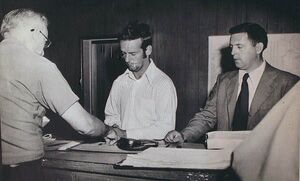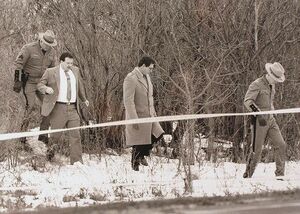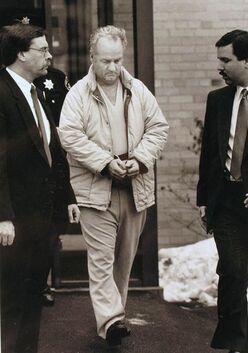Arthur John Shawcross, a.k.a. "The Genesee River Killer" or "The Rochester Strangler", was an American convicted serial killer and rapist infamous for claiming the lives of several prostitutes in 1989 after being paroled early for the murders of two children in 1972.
Background
Shawcross was born on June 6, 1945, in Kittery, Maine, but his family moved to Watertown, New York, when he was young. He was allegedly a frequent bed-wetter and had a domineering mother who would often sodomize him with foreign objects. Despite intelligence tests that determined him having an IQ of 86 (signifying low average intelligence), he received A's and B's during his first two years of grade school. When he was nine years old, Shawcross's aunt performed oral sex on him, and he allegedly had sexual relations with his sister during middle school and junior high, which prompted his mother to threaten to castrate him when she found out. In school, Shawcross had a reputation of being a bully and a rebel towards the school, usually opposing the rules in violent ways. In 1960, when he was nineteen years old, he dropped out of high school during his freshman year. Shawcross went on to marry a woman and had a son with her, but later divorced her and gave up custody rights to his son. When he was 21 years old, Shawcross was drafted in the U.S. Army in April 1967, scoring above average in intelligence tests. After spending a tour of duty in Vietnam during the war there (allegedly becoming traumatized by the experience in the process), he was assigned to Fort Sill in Lawton, Oklahoma as an armorer after said tour ended on September 1968. At this point, he had married another woman named Linda, who bore witness to the darker aspects of his personality, including a tendency to set fires; an Army psychiatrist would state that he gained "sexual enjoyment" from the fire-setting. Eventually, Shawcross and Linda moved to Clayton, New York, where he began committing crimes, including arson and burglary. Linda divorced him sometime after they arrived at Clayton. He was eventually arrested and sentenced to five years in the Attica Correctional Facility in Attica, later being transferred to the Auburn Correctional Facility in Auburn. However, after spending a total of 22 months in prison, Shawcross was paroled early, in October 1971, when he saved the life of a prison guard after a riot broke out in the facility.
Spans of Killings
Watertown Child Murders

Shawcross (middle) under arrest for the murders of Jack Blake and Karen Hill.
Upon being paroled, Shawcross then returned to Watertown, New York, where he eventually got a job with the Watertown Public Works Department, and also married for a third time. On May 7, 1972, Shawcross lured ten-year-old Jack Blake into some woods, where he sexually assaulted and then killed him. Blake disappeared near his apartment and was familiar with Shawcross, who had taken him and his brother on fishing trips several times prior to his murder. Because of the suspicious circumstances of the fishing trips, plus several conflicting stories he gave her when she confronted him, Blake's mother suspected Shawcross of being involved with her son's disappearance, but the police didn't believe her theory at first, and a body was never found. On September 2, four months after Blake's murder, Shawcross raped and killed eight-year-old Karen Ann Hill, who was visiting Watertown with her mother Helene for the Labor Day weekend. Her body was later found under a bridge crossing Black River. Since he fished under the same bridge, Shawcross became a suspect in her murder, and Detective Charles Kubinski, who was familiar with him, persuaded him to confess. Under a plea-bargain deal, Shawcross also provided information to police that proved essential to finding Jack Blake's body, which already displayed an advanced state of decomposition and therefore made it difficult to determine whether he had been sexually assaulted or not. Shawcross later pleaded guilty to killing Hill on a charge of manslaughter, while the murder charges concerning Blake were dropped. He was found guilty of the charges against him and sentenced to twenty-five years in prison as a result.
Shawcross served a total of fourteen-and-a-half years in state prison. Sometime during or before his incarceration, he apparently got into a divorce with his third wife. He was later considered a model prisoner and evaluated for the risk of repeating his crimes; during the evaluation, he was written off positively, being cited as "a safe and contributing member of society". Shawcross was later released on parole in April 1987, despite a written protest from a senior parole officer in the Binghamton, New York area. However, he had difficulty settling down in local communities, since his neighbors would continually protest against his presence and employers would fire him due to his record. He first moved to Binghamton before relocating to Delhi with his new girlfriend, Rose Marie Walley. When Shawcross's presence became known, the couple immediately moved to nearby Fleischmanns to avoid the criticism and protests, only to be met with hostility there as well. Finally, Shawcross's parole officer moved him to Rochester in late June 1987, taking him and Walley into the Cadillac Hotel, a hotel located in central Rochester, which was also used for housing transients. However, the parole officer failed to notify anyone in the Rochester law enforcement community that a child molester and killer was now living in Rochester. Additionally, his trail was covered up to prevent anyone from finding him, and his file was made inaccessible to even other police departments. Sometime in mid-October 1987, Shawcross and Walley found a more permanent residence at the Normandie Brownstone Apartments, at 253 Alexander Street in Rochester. At some point, he broke off his relationship with Walley and married a woman named Clara Neal.
Rochester Killings

Investigators at the crime scene of Shawcross's final victim, Felicia Stephens.
For unknown reasons, he began killing women, mostly prostitutes in the Lyell Avenue area. On March 18, 1989, Shawcross claimed his first victim in the second span of his killings, a 27-year-old prostitute named Dorothy "Dotsie" Blackburn, whose body was found six days later at Salmon Creek, near the Genesee River Gorge, by a hunter and his companions. Shawcross later claimed that he killed her because she bit his penis too hard during oral sex. Because of the high-risk lifestyle of the average prostitute, authorities believed that someone connected to her job was responsible for her murder, even examining the shooting and stabbing murders of two other prostitutes that occurred in the area, finding no connection. However, by October 27, three other prostitutes were found near the Genesee River, identified as Anna Steffen, Dorothy Keeler, and Patricia Ives. Because all four victims were killed by asphyxiation, local police began to investigate further into the killings, while the media, getting a hold of the case, began dubbing the killer "The Rochester Strangler" or "The Genesee River Killer". As the investigation progressed, Marie Welch disappeared, quickly followed by the discovery of the body of Frances Brown, who was initially assumed to have been Welch. On November 15, the body of Kimberly Logan, an African-American prostitute, was found in a civilian's backyard under a pile of leaves; a medical examiner found that leaves were stuffed down her throat. On Thanksgiving, the body of June Stott (who wasn't a prostitute) was found, and it was quickly deduced that she was gutted and sodomized post-mortem; a knife and a bloody towel were found nearby at the scene.
Frustrated with the rising body count of murders targeting prostitutes, a local police captain decided to call in the FBI's Behavioral Science Unit, contacting Special Agent Gregg McCrary and describing the rash of murders to him. He and New York State Trooper Lieutenant Ed Grant, a graduate of the FBI training program in criminal investigative analysis, both promptly decided to aid Rochester authorities in solving the murders. However, on November 27, before the two arrived, the body of a prostitute named Elizabeth Gibson was found, being the only victim to not be killed in Monroe County, instead being found in Wayne County, but nevertheless, she was connected to the other murders by a witness who saw her with a man who called himself "Mitch". Following this, three more prostitutes went missing: June Cicero, Darlene Trippi, and Felicia Stephens. On the morning of New Year's Eve, Felicia Stephens's belongings were discovered by a trooper patrolling a rural area. Authorities began to search for her body in the area by air, but they were complicated by the current snowy weather. Two days later, a body was found under a bridge, but it was later identified as June Cicero, who was (quite ironically) aware of the killer and took measures to avoid customers that she didn't know well. On that same bridge, they spotted Shawcross urinating there, then driving off in his Chevrolet Celebrity before police could reach him. A unit followed him to a nursing home in Spencerport, where they confronted Shawcross, who identified himself and then revealed his responsibility for the Watertown child murders. Taken to a police station under suspicion, Shawcross insisted that it was merely a coincidence that he was urinating near Cicero's crime scene, and repeatedly bragged about his accomplishments as a soldier in the Vietnam War.
Investigators were unsure if they should pin a killer pedophile on the prostitute killings, since pedophiles never change their victim types so drastically. However, suspicion on Shawcross grew further when several prostitutes, including a would-be victim, positively identified him as "Mitch". Subsequently, investigators uncovered his background and were shocked to learn the circumstances behind his release and his movement through multiple communities that was later covered up. The following morning, Felicia Stephens's body was discovered by a deer hunter, located near the spot where June Cicero's body was found. Knowing for sure that Shawcross was the killer, police began to pressure him during interviews, although he maintained his cool, dismissing the evidence against him as coincidences until an officer suspected Neal of being involved in the killings as well, to which Shawcross denied it. He then confessed to being the killer, and stated that he specifically killed Elizabeth Gibson (the only victim to be killed out of Monroe County) because she was trying to steal his wallet, and while defending himself, he projected his mother onto her and subsequently strangled her to death. He also assisted police in finding the bodies of Marie Welch and Darlene Trippi, personally leading them to the disposal sites. Eventually, Shawcross was tied to all but one of the Rochester killings: Kimberly Logan, who had leaves stuffed down her throat in the same manner as Karen Hill, the second victim of the Watertown child murders, but Shawcross denied ever killing her, although some investigators believed that he was responsible for Logan's murder. In the end, Shawcross had a court stenographer write down a 79-page-long formal confession.
Trial, Incarceration, and Death

Shawcross being led out of the Wayne County Courthouse after being arraigned for the murder of Elizabeth Gibson.
In November 1990, Shawcross was tried by the Monroe County First Assistant District Attorney, Charles J. Siragusa, for the ten murders that occurred in Monroe County. He pleaded not guilty by reason of insanity, with testimony from a psychiatrist that he suffered from dissociative personality disorder, post-traumatic stress disorder, and possible child abuse. The former stemmed from his service in the Vietnam War; his many outlandish tales of committing gruesome crimes, including cannibalism, often while he was alone in the jungle; and the horror stories he told of other people about the war when he returned from his tour of duty. Profiler Robert Ressler reviewed the PTSD claim on behalf of the prosecution before the trial, writing that his allegations about the Vietnam War were "untrue", while a psychiatrist also stated that he had antisocial personality disorder. In the end, after thirteen weeks, Shawcross was found guilty of ten counts of second-degree murder and was sentenced to a total of 250 years to life in prison for the Monroe County killings. A few months later, Shawcross was taken to Wayne County to be tried for Elizabeth Gibson's murder. He pleaded guilty to the murder and was later given a life sentence.
Afterward, Shawcross was held at the Sullivan Correctional Facility located in Fallsburg, New York, where he would remain until his death. In 2003, he was interviewed by British reporter Katherine English for a documentary on cannibalism; during the interview, Shawcross bragged about slicing out and eating the genitals of three of his victims, but refused to discuss an earlier allegation that he made of eating the genitals of his first victim, Jack Blake. In 2006, he was interviewed by Columbia University forensic psychiatrist Dr. Michael Stone for the Discovery Channel series Most Evil, which Stone presented. In the interview, Shawcross alleged that he was sexually abused by his mother when he was a child, and also admitted to sexually abusing his younger sister, also during his childhood. He also claimed that he murdered the Rochester prostitutes in revenge for supposedly having sex with an HIV-positive prostitute, and to eat the body parts in order to speed up the process of death, out of the assumption that he was infected. Stone agreed with the jury's conclusion of his allegations and did not believe that Shawcross was out of control during the prostitute murders and that he didn't have any outlandish motivations for doing so. In the afternoon of November 10, 2008, Shawcross complained of a pain in his leg. As a result, he was taken to Albany Medical Center, where he suddenly went into cardiac arrest; at 9:50 p.m., he died. Afterwards, Shawcross was cremated at a private crematorium.
Modus Operandi
Shawcross usually killed his victims by strangling them, but some of the Rochester victims were smothered with an object instead. During the Watertown child murders, he targeted Caucasian children. He sexually assaulted them before killing them, and in the case of Karen Hill, he stuffed mud, leaves, and other debris down her throat and inside her clothes for unspecified reasons. During the Rochester killings, he targeted women, mostly prostitutes, all of whom were aged in their early twenties to late fifties lived in or around Lyell Avenue. He would lure them in with an alias, kill them, and dump their bodies near the Genesee River. He would also bludgeon these victims with a blunt object, and some were kicked and bitten repeatedly in the genitals. Also, June Stott was gutted and mutilated with a knife and sodomized post-mortem, Frances Brown was also struck in the throat, Kimberly Logan had leaves stuffed down her throat, and June Cicero had her genitals mutilated with a saw post-mortem. Some of the Rochester victims were also covered with a variety of objects in the area. The Rochester victims were all killed when they provoked him in various ways, including when some threatened to actually turn him in as the killer, and before he dumped their bodies, he would hold them to the front seat of his car with a bungee cord as he drove around.
Profile
The Genesee River Killer was described by profilers as a white man in his late-20's or early-30's with a criminal record consisting of mostly sexual offenses. He likely drove a basic vehicle, was known for kinky practices, was a sportsman who worked alone, and frequented Lyell Avenue. He hadn't taken the victims far before he killed them, only a few miles from Lyell Avenue, specifically in locations that he wasn't apparently familiar to, otherwise he would not have used a vehicle of some kind to transport his victims. He was also someone with whom the victims were comfortable to, since they appeared to have gotten into the car with him without any signs of fear or reluctance, despite news coverage of the killer who was targeting prostitutes. He may also be unnoticeable, seemingly appearing normal and dressing in functional clothing. At least some of the victims may have been killed out of rage, since no evidence of overt sexual assault was found on the victims' bodies, indicating that he may have been impotent and the women subsequently ridiculed this. He may have a job, but a menial one, and was probably married or had a girlfriend. He also may be at a similar economic level as the victims, lived and worked in the city (possibly near the Lyell Avenue area), was streetwise, and was competent enough to conceal his victims from helicopter searches overhead, further indicating experience. The killer may also frequent coffee shops or bars and could be already familiar with the police.
The victim who was the most bothering was June Stott, since she suffered post-mortem mutilation in a way that none of the other victims had. It has been suggested that it was because she was either murdered by a different man or there was a change in the killer's behavior. The fact that Stott had been cut open seemed to indicate that the killer was experienced, possibly with killing and cutting up game, and that he was comfortable with bodies. He would continue to visit his victims, as long as he was confident that he could do so without getting apprehended, and he would continue to mutilate them.
Known Victims

Shawcross's victims, all of them identified clockwise:
Jack Blake, 10
Karen Hill, 8
Dorothy Blackburn, 27
Anna Steffen, 28
Dorothy Keeler, 59
Patricia Ives, 25
June Stott, 30
Marie Welch, 22
Frances Brown, 22
Kimberly Logan, 30
Elizabeth Gibson, 29
Darlene Trippi, 32
June Cicero, 34
Felicia Stephens, 20
The dates denote when the victims disappeared
- 1972, Watertown, New York:
- May 7: Jack Blake, 10 (sexually assaulted, beaten, and fatally suffocated; his body was found five months later)
- September 2: Karen Hill, 8 (raped and stuffed mud, leaves, and other debris down her throat and inside her clothes, then fatally strangled)
- 1989, Rochester, New York:
- March 18: Dorothy Blackburn, 27 (bit her vagina and strangled; her body was found six days later)
- July 9: Anna Steffen, 28 (assaulted and drowned in a river; her body was found on September 11, 1989)
- July 29: Dorothy Keeler, 59 (bludgeoned with a log; her body was found on October 21, 1989)
- September 29: Patricia Ives, 25 (sodomized and strangled; her body was found on October 27, 1989)
- October 23: June Stott, 30 (was gutted, mutilated, and sodomized post-mortem; her body was found on November 23, 1989)
- November 5: Marie Welch, 22 (strangled; her body was found on January 5, 1990)
- November 11: Frances Brown, 22 (asphyxiated; also struck in the throat; her body was found four days later)
- November 15: Kimberly Logan, 30 (possibly; was never prosecuted for her murder; leaves were also stuffed down her throat in the same manner as Karen Hill)
- November 25: Elizabeth Gibson, 29 (strangled; killed in Wayne County instead of Monroe County; her body was found two days later)
- December 15: Darlene Trippi, 32 (asphyxiated; her body was found January 5, 1990)
- December 17: June Cicero, 34 (strangled; her genitals were mutilated with a saw post-mortem; her body was found on January 3, 1990)
- December 28: Felicia Stephens, 20 (incidental; strangled; her body was found three days later)
- Note: Shawcross claimed to have committed his first murders while serving in Vietnam, killing two young local girls and eating their bodies. He was also responsible for numerous other crimes, which include arson and burglary.
On Criminal Minds
Though he was not mentioned or referenced in Criminal Minds, Shawcross' mugshot was seen on the cover of the book America's Deadliest Killers, which was read by Michael Peterson in Tribute. He also has some slight similarities to Hugh Rollins, a budding serial killer who appeared in A Shade of Gray. Both were sex offenders who raped and killed two children by strangling them and then dumped their bodies in secluded areas of the woods. His tendency to bring his unknowing wife to the scenes of his murders seems to be alluded in Zoe's Reprise, where Eric Olson took his girlfriend to the scenes of his own murders to have sex there.
Sources
- Wikipedia's article about Shawcross
- TruTV Crime Library articles about Shawcross
- Democrat and Chronicle PhotoGallery's gallery of photos relating to Shawcross
- CNYCentral article detailing Shawcross's death
- Robert Keller's blog article about Shawcross
- Murderpedia's page about Shawcross's victims
- Crime and Investigation's article about Shawcross
